
Round five report
| Round
5: Sunday, December 13, 2009 |
| David Howell |
½-½ |
Vladimir Kramnik |
| Hikaru Nakamura |
0-1 |
Luke McShane |
| Ni Hua |
0-1 |
Magnus Carlsen |
| Michael Adams |
½-½ |
Nigel Short |
|
There were two decisive games in an exciting round at the London Chess Classic
today. Magnus Carlsen stretched his lead to three points over Vladimir Kramnik,
while Luke McShane won again to move into third place.
Before moving onto a blow-by-blow account of round five, let’s clear
up a couple of errors from round four. One was in the original issue of the
press release, where we tried to tell you that Short-Ni Hua was the round four
best game winner. I hope neither of those gentlemen nipped out to spend their
500 euros (each) on Christmas presents on the strength of this comment because
it was wrong. The best game winners of round four were Carlsen and Nakamura
(shared). The other error was by the aforementioned Carlsen and (to a lesser
extent) Nakamura.

At yesterday’s press conference Carlsen told the audience that he regretted
playing 32 Qe2 and wished he had played 32 Re2. Nakamura backed him up and the
opinion was related to a packed commentary room. Nobody present spotted that
32 Re2 had a huge flaw and would have lost instantly (we’re assuming that,
at the chessboard, Hikaru would have found what he missed during commentary),
but all our computers found it instantly. You can find it mentioned in yesterday’s
game annotations.
After his game today, and before commenting on his round five, Magnus Carlsen
came to the commentary room and delivered rather a delightful little speech,
owning up to the unsoundness of the line he advocated at yesterday’s commentary
session and advising us against taking anything he said in his post-round comments
as gospel. It went down very well with the audience. Magnus has remarkable poise
for a young man of tender years and he’s made a big hit with the London
chess audience. You’ll remember that Big Vlad had some problems getting
into the country; I’m rather hoping that Britain’s over-zealous
passport authorities will take similar action when Magnus tries to get out of
Britain after the tournament. We’d like to keep him.
In today’s round, Carlsen was soon out of the ‘book’ (as
he admitted afterwards) and the watching grandmasters were not too convinced
about the safety of his position for the first part of the game. It is possible
that Ni Hua could have made more of some early attacking chances but the Norwegian
soon consolidated and, slowly but surely, outplayed his opponent. The game seemed
to hinge on a couple of judgement calls; in particular, compare and contrast
the trajectory of the two kings in the final phase of the game.
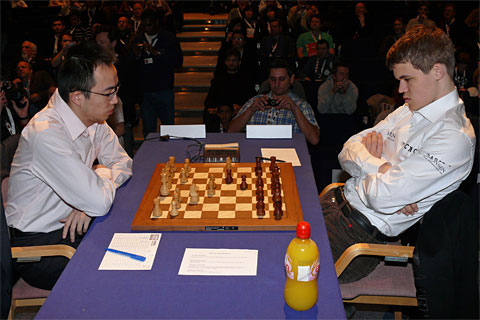
Ni Hua (2665) - Carlsen,Magnus (2801) [B51]
London Chess Classic London (5), 13.12.2009 [John Saunders]
1.e4 c5 2.Nf3 d6 3.Bb5+ Nd7 4.d4 a6 5.Bxd7+ Bxd7

6.dxc5 dxc5 7.Nc3 e6 8.Bf4 Ne7 9.Ne5. This sort of thing has been played
before but not in this exact position. Magnus admitted that he was soon out
of his theory. 9...Ng6 10.Qh5!? This sort of move is easily overlooked.
10...Bc6. 10...Nxf4?? allows mate in one, while 10...Nxe5? 11.Bxe5 makes
it very hard to develop Black's kingside. 11.Bg3 Nxe5 12.Bxe5 c4 13.0-0.
Magnus said he was wasn't so concerned about this move. He had expected
13.f4 which is a bit more aggressive. 13...Qa5. Magnus's view given in
the commentary room was that most of his problems were over around this point.
But to the less sophisticated eye (i.e. virtually everybody else on the planet),
he doesn't seem to be out of the wood yet. 14.Qg5
It is not obvious where Black can stow his king in this position but Magnus
comes up with what looks like a very risky solution. 14...h6 15.Qg3 f6. This
looks like a self-inflicted wound: the horrid weakness on g6 most chessplayers
would find repellent. But chess geniuses can assess a position on its merits.
16.Qg6+ Ke7. The previous day Ni Hua had gone in for a similar ugly king
move which blocked his own bishop on f8. 17.Bf4 Be8. This patches up
the light square weakness but does nothing to help develop the pieces or connect
the rooks. 18.Qg3 Kf7 19.Rad1 Bc6 20.Rd2. Magnus thought 20.a3 was better
and, for once, it is possible to understand fully what he has in mind. It stops
the black bishop coming to b4 where it causes some annoyance. 20...e5 21.Be3
Bb4. This line is not without risk for Black as White can try to open up
lines against his king. 22.f4 Rhe8! A key defensive move. Carlsen had
calculated that his king should be reasonably safe from attack after this. 23.f5
Bc5 24.Rfd1 Rad8 25.Rxd8 Bxe3+ 26.Qxe3 Rxd8 27.Rxd8 Qxd8. Once the rooks
are off, the position starts to turn inexorably in favour of Black. 28.Kf2
Qd6 29.a3. Otherwise Qb4 will be a nuisance. 29...a5
This looks like a fairly balanced position and your chess engine will probably
pronounce it equal, or perhaps slightly better for Black because he has bishop
for knight. That is probably about right and yet the position soon swings markedly
in favour of Black. One crucial aspect over the next few moves is what the players
do with their kings. Keep a watchful eye on the monarchs as the game unfolds...
30.Kf3. Here the game gets very grandmasterly. Carlsen felt that 30.Ke2
was more precise though he did not articulate this sentiment in such a way that
that we chess mortals could fully appreciate the difference. 30...Kg8. Carlsen
chooses to move his king backwards to safety. He wants it to have the option
of hiding on h7 should a white queen attack it along the back rank. Another
motive was possibly the provision of a square for the bishop to occupy and put
pressure on the a2-g8 diagonal. 31.g3 b5 32.Ke2 b4 33.axb4 axb4 34.Nd1 Ba4
35.b3?! Magnus thought the text was inferior. We looked at 35.Qd2 Qd4
and Black certainly gets a lot of pressure but nothing absolutely decisive.
35 b3 opens up the f1-a6 diagonal and this exposes the white king to danger.
35...cxb3 36.cxb3 Qa6+ 37.Kd2?! In time trouble, Ni Hua starts to make
a few slight errors which, when added together, make a big one. 37 Ke1 is better.
37...Bb5 38.Qc5 Qa2+ 39.Qc2? The final error. 39.Kc1 is better, though
Black still has problems after 39...Be2 . That said, 40.Ne3!? Qxb3 41.Qd5+ Qxd5
42.exd5 might just be OK for White. 39...Qa7! Black's command of the
two diagonals catches the eye. 40.Qc8+ White reaches the time control
with a check. There doesn't seem to be anything significantly better for White
since 40.g4 Kh7 41.h3 Qd4+ 42.Kc1 Bd3 wins the e4 pawn, with a very comfortable
positional plus. 40...Kh7. Black's king finds a safe haven but its adversary
remains horribly exposed. Notice that the e8 square, where White would dearly
like to post his queen to threaten perpetual check, is controlled by the bishop.
41.Kc1 Qa1+ 42.Kc2 Qd4. The e4 pawn cannot be saved and, without any
hope of positional compensation, White decides he has had enough. 0-1. [Click
to replay]

Immediately after his game Magnus Carlsen is interviewed by a batrachian
camera team
The above fairly impolite joke was examined and authorised by GM Robert Fontaine,
who is anchoring the video reports for Europe Echecs in London. It was instigated
by Nigel Short, a leading collector of obscure words.
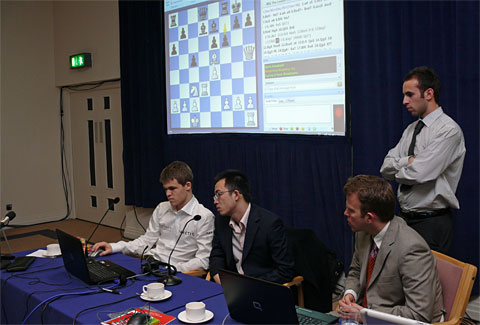
Magnus and Ni Hua analyse for the spectators in London and on Playchess
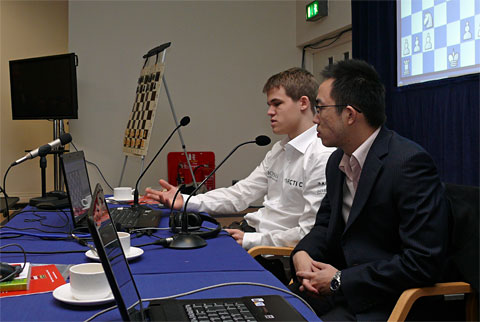
The young Nowegian advised people against taking anything he said in his post-round
comments as gospel
Some months ago Nigel Short took back the title of England number one from
Michael Adams; surprisingly so, perhaps, since Nigel is 44 to Michael’s
38 and we have become accustomed to other leading players fading in their forties.
So their meeting today was a chance for Michael to regain his crown. The opening
was a Open Ruy Lopez, which Nigel has only recently started playing for Black
but with some success. He has evidently hit upon a system which suits him well
as he seemed to have an edge for much of today’s game with Michael. Just
before the time control he may have slipped up slightly with 39...g5 as he admitted
he had completely overlooked Michael’s reply 40 e6, threatening to queen
a pawn. In the commentary room Nigel confessed he was relieved to find he had
one saving move which led to the draw.
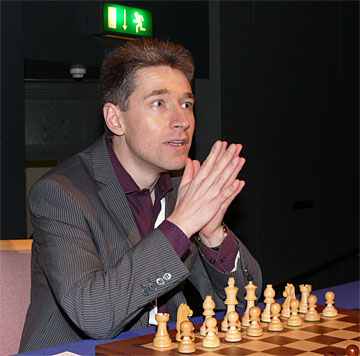
Trying to get back to number one in Britain: Michael Adams
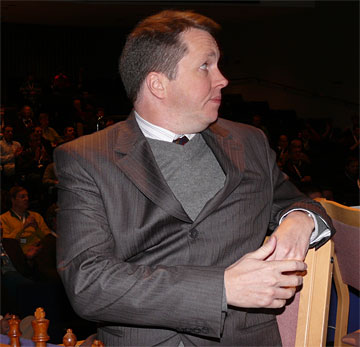
Top slot at 44: former world championship challenger Nigel Short
Adams,Michael (2698) - Short,Nigel (2707) [C80]
London Chess Classic London (5), 13.12.2009
1.e4 e5 2.Nf3 Nc6 3.Bb5 a6 4.Ba4 Nf6 5.0-0 Nxe4 6.d4 b5 7.Bb3 d5 8.dxe5
Be6 9.Nbd2 Nc5 10.c3 Nxb3 11.Nxb3 Be7 12.h3 0-0 13.Re1 a5 14.a4 bxa4 15.Rxa4
Qd7 16.Nbd4 Nxd4 17.cxd4 Rfb8 18.Bd2 Rxb2 19.Rxa5 Rxa5 20.Bxa5 Bf5 21.Bc3 Rb6
22.Kh2 h6 23.Qa1 Rg6 24.Bd2 Kh7 25.Qc3 Be4 26.Qe3 Qf5 27.Qf4 Qxf4+ 28.Bxf4 c5
29.dxc5 Bxc5 30.Be3 d4 31.Bd2 Bd5 32.Rc1 Ba7 33.Ra1 Bb6 34.Ra4 d3 35.Be3 Bc7
36.Bf4 Rc6 37.Rd4 Bxf3 38.gxf3 Rc3 39.Kg2 g5 40.e6 Bb6 41.Rxd3 Rxd3 42.e7 Rd8
43.exd8Q Bxd8 1/2-1/2. [Click
to replay]

Nigel and Mickey – the two top Brits analyse their game in the commentary
room

The queue of GMs: Magnus Carlsen and Ni Hua wait for their turn to analyse
Next up, a mouth-watering pairing between Hikaru Nakamura and Luke McShane:
Hikaru never fails to entertain and Luke is once again fully focused on chess
so this was a sure-fire winner as far as the crowd was concerned. Luke decided
to stick with his Na6 variation of the King’s Indian Defence with which
he lost to Magnus and his bravery was rewarded, not just with his second win
but with the round’s best game prize of 1,000 euros. Well done, Luke,
but also credit to Hikaru for a battling performance.

Nakamura,Hikaru (2715) - McShane,Luke (2615) [E94]
London Chess Classic London (5), 13.12.2009 [John Saunders]
1.d4 Nf6 2.c4 g6 3.Nc3 Bg7 4.e4 d6 5.Be2 0-0 6.Nf3 e5 7.0-0 Na6 8.Be3 Ng4
9.Bg5 Qe8 10.c5!? This imbalances the position and ensures that it will
not be a stereotypical KID game. 10...exd4 11.Nd5 Be6. 11...Nxc5 12.Nxc7
Qxe4 13.Re1 Rb8 14.Bc4 Qf5 15.Be7 was played in Navara-McShane, Gothenburg 2005,
and White eventually won. 12.Be7!? [Another bold decision by Hikaru.
He probably looked at 12.Bxa6 Bxd5 13.exd5 bxa6 14.cxd6 cxd6 15.Nxd4 Qd7 and
decided it didn't offer him enough. Chess engines seem to like it but it is
not clear that White has sufficient play.] 12...Bxd5 13.Bxf8 Qxf8 14.exd5
dxc5
Black has two pawns and a knight for the rook, so the material situation is
fairly balanced. 15.Qb3 Rb8 16.Rfe1 Qd6 17.h3. White has to be wary
of all those black pawns on the queenside. For example, 17.Bc4? b5! and if 18.Bxb5
c6! 19.dxc6 Nc7 20.a4 a6 and the bishop is lost; 17.Qa4!? may be a canny move
to restrain a queenside advance. 17...Nf6 18.Bxa6. After this, Black
seems to be slightly in the ascendant. Perhaps something less committal, such
as 18 a3, was called for. 18...Qxa6 19.Rac1 Bf8 20.Ne5 Qb6 21.Qf3 Qd6
22.g4?! Too gung ho. 22.Nd3!? was more cautious, restraining Black's
queenside pawns: 22...b6 23.b4 Nxd5 24.bxc5 bxc5 25.Rxc5 Nf4 26.Rec1 looks playable.
22...Bh6! Grabbing some important dark squares. Black even has dreams
of advancing a pawn to d2 one day. 23.Rc2 Re8 24.Rce2 Rf8 25.Nc4 Qxd5 26.Qxf6
Bg7!? Probably better than the immediate 26...Qxc4 27.Re8 when, for example,
the pawn grab 27...Qxa2? runs into 28.g5! Bg7 29.Rxf8+ Bxf8 30.Re8 and Black
finds he has no defence to 31 Qe7 and mate. 27.Qh4. 27.Qf4 may be better
but Black still has 27...Qxc4 28.b3 Qd5 29.Qxc7 d3 30.Re7 Bc3 with a probable
win in sight. 27...Qxc4 28.Re8 Qd5 29.Rxf8+ Bxf8 30.Re8 Kg7
31.g5. It's beginning to look very difficult for White. He could try
31.Qd8 Qxd8 32.Rxd8 but that may be quite similar to the text in the long run.
31...Qd6. Black has now completed his king's defensive set-up and can
turn his attention to march his queenside pawns down the board. 32.Kf1 b5
33.Ke1. White wants to use his king to block the advance of the pawns. 33...c4
34.Qe4 c5 35.h4 c3 36.bxc3 dxc3 37.Qe5+. A difficult decision but probably
best. 37...Qxe5+ 38.Rxe5 a5 39.Kd1 a4 40.a3 b4 41.Kc2
White appears to have stymied the pawn advance but Black has one more trick
in his locker. 41...h6! The idea behind this move is simply to give his
king a square on h7 so that he can put the bishop on g7 and play b3+. 42.Rd5?
42.Re8 Bd6 43.Ra8 gives Black a lot more problems than the text. 42...hxg5
43.hxg5 Kh7 44.Rd7
44...Bg7! The loss of the f7 pawn, and what is effectively a self-pin,
matter far less than the opportunity to advance the b-pawn another square. 45.Rxf7
b3+ 46.Kb1 Kg8 47.Ra7 Bd4 48.Rxa4 Kf7 49.Ra6. If 49.Ra7+ Ke6 50.Rb7 c4
and the phalanx of black material is invulnerable, e.g. 51.Rc7 Kd5 52.Rd7+ Ke4
and the black king sets up a mating finish. 49...Be5 50.Ra4. The rook
has to stop the big threat of c2+ and Bf4+ and so lets the black king in. 50...Ke6
51.Rh4 Kd5 52.a4 c4 53.Rh1 c2+ 54.Kc1 c3 55.Rh4 Bd6. Mate follows in only
two moves. 0-1. [Click to
replay]

Luke analyses while Lawrence Trent, Jon Rowson, Malcolm Pein, Stephen Gordon...
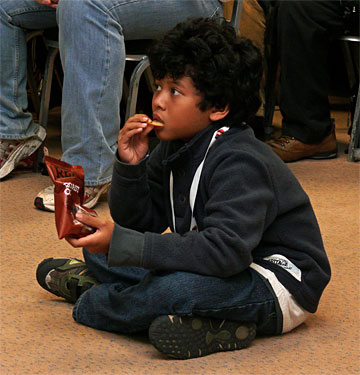
... and a young crisp-chewing chess fan look on.

After the lecture Luke poses with chess fans Thea-Lina and Veronika from Germany
The final game to finish was Howell-Kramnik. Watching this game brought back
memories of 1 March 2002 when the 11-year-old David Howell played a short exhibition
match, sponsored by Einstein.tv, against world champion Vladimir Kramnik in
London. Take a look at the photo I took then...
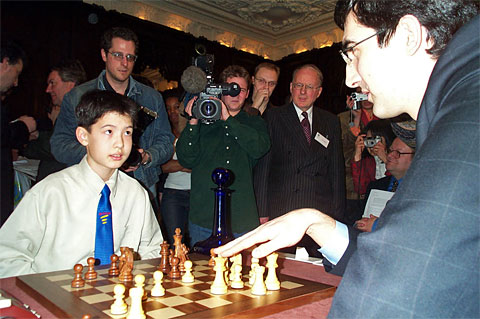
David Howell drew
a game against Vladimir Kramnik in 2002 [photo John Saunders]
Was that only seven years ago? David was just a little boy then but he’s
a tall young man these days (though not as tall as Big Vlad – few people
are). David got a draw in the fourth of four games in 2002, setting a record
for the youngest player to draw with a world champion. Of course, that was just
a bit of fun – let’s say that Vlad may not have been playing at
full throttle. But he certainly was today and he couldn’t overcome England’s
top teenager.
The game featured an early repetition but it was David who stopped the sequence.
That is not to say that Vlad would not have desisted from a possible threefold
repetition himself next move. This is favourite psychological trick of many
grandmasters. At move 20 there came a tactical trick from the ex-world champion
and it looked as though Howell’s defences might have been seriously breached.
But, not for the first time in the tournament, Howell showed resourcefulness
under pressure to reach a fairly decent middlegame position where he had bishop
and knight for rook and two pawns. Kramnik huffed and puffed but couldn’t
blow his house down. He went out on a limb rather and even seemed at risk of
losing at one point. It ended in a draw but was a splendid game which is worthy
of study.
Another great round, with huge numbers of spectators watching in person and
online. The current scores are Carlsen 11/15, Kramnik 8, McShane 7, Adams, Howell
5, Nakamura, Short 4, Ni Hua 3. It is curious to note that just three of the
eight players have wins to their names as yet, but all three of them have at
least two of them. Magnus and Vlad are two of the three but the third is home-town
boy Luke McShane who is showing how to exploit the 3-1-0 scoring system, as
he is two points up on the two other players who, like him, have a 50% score.
Howell,David (2597) - Kramnik,Vladimir (2772) [C42]
London Chess Classic London (5), 13.12.2009
1.e4 e5 2.Nf3 Nf6 3.Nxe5 d6 4.Nf3 Nxe4 5.d4 d5 6.Bd3 Nc6 7.0-0 Be7
8.Re1 Bg4 9.c3 f5 10.Qb3 0-0 11.Nbd2 Na5 12.Qa4 Nc6 13.Qb3 Na5 14.Qc2 Nc6 15.b4
a6 16.Rb1 b5 17.a4 Rb8 18.axb5 axb5 19.Ne5 Nxe5 20.dxe5 Nxf2 21.Kxf2 Bh4+ 22.Kf1
Bxe1 23.Kxe1 Qh4+ 24.g3 Qxh2 25.Nf1 Qxc2 26.Bxc2 Rbe8 27.Bd3 Rxe5+ 28.Kf2 f4
29.gxf4 Bf5 30.Bxf5 Rexf5 31.Ng3 R5f6 32.Kf3 Rc6 33.Bd2 g5 34.Ne2 gxf4 35.Nd4
Rg6 36.Nxb5 Rg3+ 37.Kf2 Rd3 38.Rg1+ Kh8 39.Ke2 Rg3 40.Kf2 Rxg1 41.Kxg1 c5 42.Nd6
cxb4 43.cxb4 Kg7 44.Bc3+ Kg6 45.b5 Rd8 46.Be5 Rb8 47.Bd4 Rd8 48.Be5 Rb8 49.Kf2
Rb6 50.Kf3 Kg5 51.Nf7+ Kg6 52.Nd6 Kg5 53.Nf7+ Kg6 1/2-1/2. [Click
to replay]
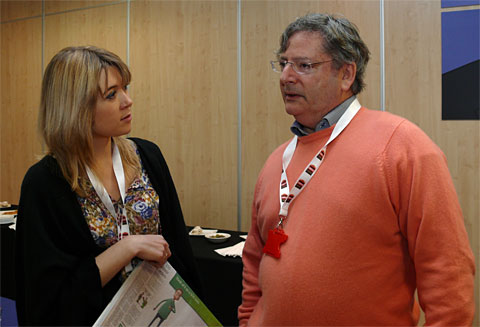
Colleagues comparing notes in the VIP room: Marie-Laure Kramnik writes op-eds
for
Le Figaro in Paris, Dominic Lawson for The Independent and The Sunday Times
in London
Pictures by Frederic Friedel in London
About the author of the London reports
John Saunders started playing competitive chess at school in High Wycombe
and was lucky enough to join the Cambridge University Chess Club when
it was the strongest club in the UK. He studied law and classics at university
and had a 20-year career as a public sector IT specialist before becoming
editor of British Chess Magazine
in 1999. As well as being editor, typesetter and webmaster for the magazine,
he writes articles and takes photos. He is the regular webmaster/journalist
for the Gibtelecom Chess
Festival, and performed a similar function for the 2001-2007 Monarch
Assurance Isle of Man Congresses and the 2008 European Union Championship
in Liverpool. He writes the chess page for BBC TV’s Ceefax service.
John plays hardly any chess these days but, when he did, he reached a
FIDE Rating of 2255 and represented Wales in the 1997 European Team Championship.
He is married, with two cats, and lives in Kingston-upon-Thames, Surrey. |
|
Standings
No. |
Player |
wins |
draws |
losses |
points |
Perf. |
1 |
Magnus Carlsen |
3 |
2 |
0 |
11 |
2913 |
2 |
Vladimir Kramnik |
2 |
2 |
1 |
8 |
2747 |
3 |
Luke McShane |
2 |
1 |
2 |
7 |
2718 |
4 |
Michael Adams |
0 |
5 |
0 |
5 |
2691 |
5 |
David Howell |
0 |
5 |
0 |
5 |
2719 |
6 |
Hikaru Nakamura |
0 |
4 |
1 |
4 |
2625 |
7 |
Nigel Short |
0 |
4 |
1 |
4 |
2586 |
8 |
Ni Hua |
0 |
3 |
2 |
3 |
2590 |
|
|
Scoring System:
3 - Points per win
1 - Point per draw
0 - Points per loss |
Traditional cross table (for rating purposes)
Schedule and results
| Round
1: Tuesday, December 8, 2009 |
Magnus Carlsen |
1-0 |
Vladimir Kramnik |
Luke McShane |
1-0 |
Nigel Short |
David Howell |
½-½ |
Michael Adams |
Hikaru Nakamura |
½-½ |
Ni Hua |
|
|
| Round
2: Wednesday, December 9, 2009 |
| Vladimir Kramnik |
1-0 |
Ni Hua |
| Michael Adams |
½-½ |
Hikaru Nakamura |
| Nigel Short |
½-½ |
David Howell |
| Magnus Carlsen |
1-0 |
Luke McShane |
|
|
| Round
3: Thuesday, December 10, 2009 |
| Luke McShane |
0-1 |
Vladimir Kramnik |
| David Howell |
½-½ |
Magnus Carlsen |
| Hikaru Nakamura |
½-½ |
Nigel Short |
| Ni Hua |
½-½ |
Michael Adams |
|
|
Friday, December 12, 2009
Rest day
|
|
| Round
4: Saturday, December 12, 2009 |
| Vladimir Kramnik |
½-½ |
Michael Adams |
| Nigel Short |
½-½ |
Ni Hua |
| Magnus Carlsen |
½-½ |
Hikaru Nakamura |
| Luke McShane |
½-½ |
David Howell |
|
|
| Round
5: Sunday, December 13, 2009 |
| David Howell |
½-½ |
Vladimir Kramnik |
| Hikaru Nakamura |
0-1 |
Luke McShane |
| Ni Hua |
0-1 |
Magnus Carlsen |
| Michael Adams |
½-½ |
Nigel Short |
|
|
| Round
6: Monday, December 14, 2009 |
| Vladimir Kramnik |
- |
Nigel Short |
| Magnus Carlsen |
- |
Michael Adams |
| Luke McShane |
- |
Ni Hua |
| David Howell |
- |
Hikaru Nakamura |
Games – Report |
|
| Round
7: Tuesday, December 15, 2009 |
| Hikaru Nakamura |
- |
Vladimir Kramnik |
| Ni Hua |
- |
David Howell |
| Michael Adams |
- |
Luke McShane |
| Nigel Short |
- |
Magnus Carlsen |
Games – Report |
|
Tournament Schedule
| Monday |
7th December |
Press Conference + blindfold display |
|
Tuesday |
8th December |
Round 1 |
2.00pm |
Wednesday |
9th December |
Round 2 |
2.00pm |
Thursday |
10th December |
Round 3 |
2.00pm |
| Friday |
11th December |
Rest day and Community / School events |
|
Saturday |
12th December |
Round 4 |
2.00pm |
Sunday |
13th December |
Round 5 |
2.00pm |
Monday |
14th December |
Round 6 |
2.00pm |
Tuesday |
15th December |
Round 7 |
12.00pm |





































































